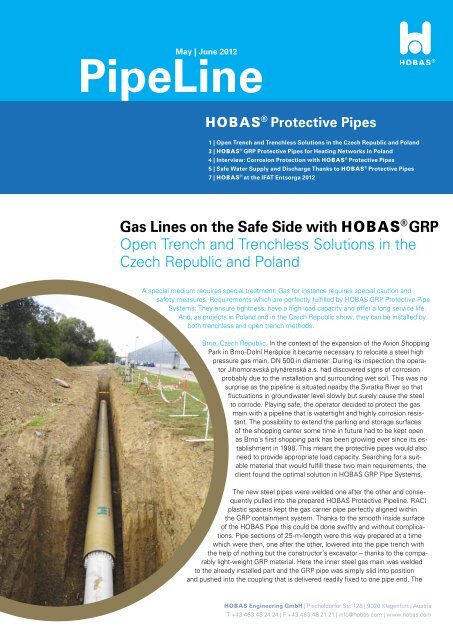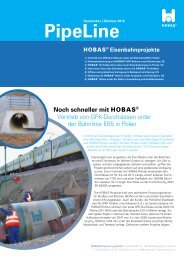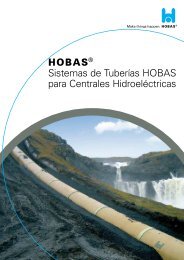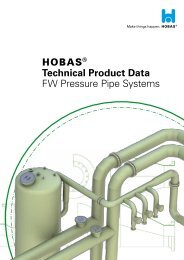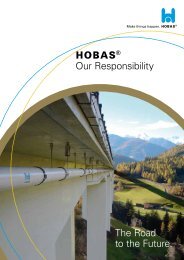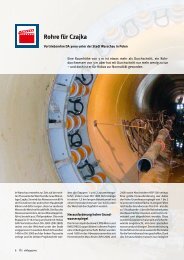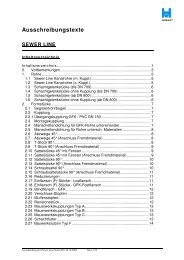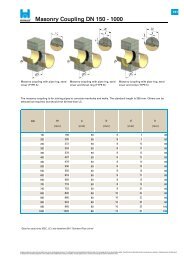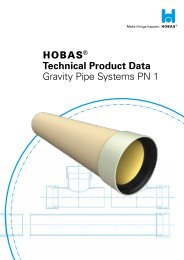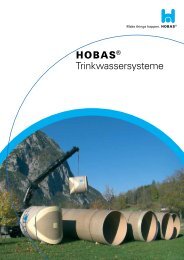Protection Pipes - hobas
Protection Pipes - hobas
Protection Pipes - hobas
You also want an ePaper? Increase the reach of your titles
YUMPU automatically turns print PDFs into web optimized ePapers that Google loves.
May | June 2012<br />
PipeLine<br />
h Protective <strong>Pipes</strong><br />
1 | Open Trench and Trenchless Solutions in the Czech Republic and Poland<br />
3 | h GRP Protective <strong>Pipes</strong> for Heating Networks in Poland<br />
4 | Interview: Corrosion <strong>Protection</strong> with h Protective <strong>Pipes</strong><br />
5 | Safe Water Supply and Discharge Thanks to h Protective <strong>Pipes</strong><br />
7 | h at the IFAT Entsorga 2012<br />
Gas Lines on the Safe Side with h GRP<br />
Open Trench and Trenchless Solutions in the<br />
Czech Republic and Poland<br />
A special medium requires special treatment. Gas for instance requires special caution and<br />
safety measures. Requirements which are perfectly fulfilled by HOBAS GRP Protective Pipe<br />
Systems: They ensure tightness; have a high load capacity and offer a long service life.<br />
And, as projects in Poland and in the Czech Republic show, they can be installed by<br />
both trenchless and open trench methods.<br />
Brno, Czech Republic. In the context of the expansion of the Avion Shopping<br />
Park in Brno-Dolní Heršpice it became necessary to relocate a steel high<br />
pressure gas main, DN 500 in diameter. During its inspection the operator<br />
Jihomoravská plynárenská a.s. had discovered signs of corrosion<br />
probably due to the installation and surrounding wet soil. This was no<br />
surprise as the pipeline is situated nearby the Svratka River so that<br />
fluctuations in groundwater level slowly but surely cause the steel<br />
to corrode. Playing safe, the operator decided to protect the gas<br />
main with a pipeline that is watertight and highly corrosion resistant.<br />
The possibility to extend the parking and storage surfaces<br />
of the shopping center some time in future had to be kept open<br />
as Brno’s first shopping park has been growing ever since its establishment<br />
in 1998. This meant the protective pipes would also<br />
need to provide appropriate load capacity. Searching for a suitable<br />
material that would fulfill these two main requirements, the<br />
client found the optimal solution in HOBAS GRP Pipe Systems.<br />
The new steel pipes were welded one after the other and consequently<br />
pulled into the prepared HOBAS Protective Pipeline. RACI<br />
plastic spacers kept the gas carrier pipe perfectly aligned within<br />
the GRP containment system. Thanks to the smooth inside surface<br />
of the HOBAS Pipe this could be done swiftly and without complications.<br />
Pipe sections of 25-m-length were this way prepared at a time<br />
which were then, one after the other, lowered into the pipe trench with<br />
the help of nothing but the constructor’s excavator – thanks to the comparably<br />
light-weight GRP material. Here the inner steel gas main was welded<br />
to the already installed part and the GRP pipe was simply slid into position<br />
and pushed into the coupling that is delivered readily fixed to one pipe end. The<br />
E Engineering GmbH | Pischeldorfer Str. 128 | 9020 Klagenfurt | Austria<br />
T +43.463.48 24 24 | F +43.463.48 21 21 | info@<strong>hobas</strong>.com | www.<strong>hobas</strong>.com
HOBAS System’s FWC couplings with their elastomer<br />
rubber gasket are indeed a further plus as they not only<br />
facilitate the assembly thanks to simple push-to-fit<br />
mounting but also accommodate angular deflection<br />
while remaining tight – a perfect feature that helps<br />
omit costly fittings on gently curved routes. Once<br />
a pipe section had been completed the ends were<br />
capped with a rubber seal to keep the line clean.<br />
A total 156 meters of HOBAS Protective Pipe<br />
DN 700, PN 1, SN 10000 were this way successfully<br />
installed during September 2011 and ensure trouble<br />
free, safe service for the next decades.<br />
River Warthe, Poland. A technically, in terms of installation,<br />
challenging protective pipeline project was initiated<br />
by the company Warszawskie Przedsiębiorstwo<br />
BETA in October 1998 in Poland. It comprised the jacking<br />
of a twin pipe under the Warta River. Two paralleling<br />
lines, 105 and 108 m in length, were executed 50 meters<br />
from each other. The 3-m-long microtunnelled HOBAS<br />
Jacking <strong>Pipes</strong> have a diameter of 2047 mm and a wall thickness<br />
of 70 mm.<br />
h PipeLine | May/June 2012 | Page 02<br />
What was the purpose of the undertaking? The to date most modern<br />
guided drilling technique and CC-GRP <strong>Pipes</strong> were employed to<br />
overcome an obstacle presented by the Warta river on the construction<br />
route of the Yamal-Europe Pipeline, that transports pressurized gas from<br />
the Siberian Yamal Penninsula all the way to Germany. In addition to the<br />
two steel carrier pipes, 1450 mm in diameter, the GRP pipes should also<br />
accommodate a fiber optic cable.<br />
Drilling was conducted in 13 meters depth, 7 meters below the river bed.<br />
Despite the large clearance between pipe and river, microtunneling was<br />
executed under pressure reaching a level of 1.5 bar due to deep groundwater.<br />
The challenge was increased by the diverse geological structure:<br />
While the starting pits on one side of the river were surrounded by clay,<br />
the receiving pits were situated in in permeable soil (sand and gravel).<br />
The contractor was forced to seal the soil around the latter to prevent<br />
too much water from running into the pit. If this were not enough, the<br />
temperatures fell to as low as -25° degrees which was no problem for<br />
HOBAS GRP but made installation arduous for manpower.<br />
In addition to standard jacking pipes, HOBAS supplied also CC-GRP <strong>Pipes</strong><br />
equipped with nozzles through which a lubricant is pumped between the<br />
outer wall of the pipe and the surrounding soil during microtunneling. The<br />
low roughness coefficient of HOBAS Pipe Systems alone requires low<br />
jacking forces; by adding a lubricant the average force could in this case be<br />
lowered to an equivalent of approximately 250 tons.<br />
The job was successfully completed beginning of 1999 meeting all requirements<br />
set by the investor, who happily looks back to over 10 years of<br />
service.<br />
>>Tweet
h PipeLine | May/June 2012 | Page 03<br />
GRP Protective <strong>Pipes</strong> for Heating Networks in Poland<br />
A Pinch of Polish h History<br />
Protective pipes from steel have long been the first choice in pre-insulated<br />
pipeline engineering. They are however vulnerable to corrosion, particularly<br />
stray current corrosion (SCC). HOBAS GRP <strong>Pipes</strong> present a remedy for this<br />
problem – the Polish heating company SPEC, for instance, has realized this<br />
and has been using GRP for over a decade.<br />
In 1998, for the construction of a pre-insulated heating distribution<br />
pipe under Wołowska Street in Warsaw, the Warsaw Heating Company<br />
SPEC S.A. decided to search for an alternative that would<br />
withstand high static loads, that can be installed via trenchless<br />
methods and is also insensitive to stray currents. The choice fell<br />
on HOBAS GRP <strong>Pipes</strong>; the glassfiber reinforced polyester pipes<br />
are dielectric and not only meet the requirements set by SPEC<br />
but offer numerous additional convincing benefits.<br />
Centrifugally cast HOBAS GRP Jacking <strong>Pipes</strong> 324 mm in<br />
outside diameter were installed to accommodate the<br />
DN 150 heating line. To facilitate the jacking procedure<br />
HOBAS Poland delivered the standard 6-m-long pipes readily<br />
cut into 1-m-sections. The admissible jacking force determined<br />
by HOBAS equaled 30 tons. Not least thanks to the pipes’ benefits<br />
such as their smooth outer surface, however, the highest<br />
force recorded during implementation did not exceed 20 tons. Due<br />
to the non-disruptive trenchless installation method the works could<br />
be conducted during normal traffic conditions.<br />
Since 1998 HOBAS Pipe Systems have been employed in about 90 heating<br />
pipe projects in Poland – aligning all delivered GRP pipes this would<br />
result in an 11-km-long line. Most of the projects have been realized in<br />
Warsaw and its surroundings. The pipes, mainly DN 300 to DN 1800 mm<br />
in diameter, are often installed in open trench and are therefore designed<br />
with a stiffness SN 10000; in many other cases they were realized with<br />
a higher stiffness suitable for trenchless installation.<br />
Currently, HOBAS Protective <strong>Pipes</strong> are installed beneath Kasprowicza<br />
Street in Warsaw for the client SPEC DALKIA Warszawa. This<br />
job was initiated along with the construction of Marie Skłodowskiej-<br />
Curie Bridge as the existing district heating network in the dense<br />
underground infrastructure needed to be restructured. HOBAS GRP<br />
Products were a natural choice due to their outstanding parameters<br />
which facilitate the installation despite the heavy traffic in the city<br />
and allow a relatively thin pipe cover. The tight project schedule was<br />
a further key factor which let the client opt for HOBAS. Construction<br />
works at Kasprowicza Street commenced April 10 and are planned to<br />
be finalized in June 2012.<br />
>>Tweet
h PipeLine | May/June 2012 | Page 04<br />
Corrosion <strong>Protection</strong> with h <strong>Protection</strong> <strong>Pipes</strong><br />
An interview with Stefan Scheiflinger (SCS), Head of Innovation<br />
Management and Application Development, HOBAS Engineering Austria.<br />
What are protective pipes used for?<br />
SCS: Protective pipes are used to protect sensitive utilities such as e.g.<br />
pipelines. There are various reasons for which protection is used: for<br />
example as extra precaution and protection against mechanical damage on<br />
e.g. gas pipelines, to protect the environment when transporting dangerous<br />
mediums or to maintain structural safety for roads or buildings above<br />
the pipe if the carrier alone does not provide enough load capacity.<br />
What makes HOBAS <strong>Pipes</strong> so suitable protective pipes?<br />
SCS: HOBAS <strong>Pipes</strong> have a long service life and are highly resistant to permeability.<br />
They can be adapted to suit every external load and are therefore<br />
very robust regarding deformation, ruptures and cyclic loads. The outstanding<br />
corrosion resistance of GRP products and their light weight are further<br />
advantages that make HOBAS Protective <strong>Pipes</strong> many a clients’ first choice.<br />
For which applications fields are HOBAS <strong>Pipes</strong> especially suitable?<br />
SCS: HOBAS <strong>Pipes</strong> are particularly often used when protective pipes are<br />
laid via the trenchless method jacking. Thanks to centrifugal casting GRP<br />
pipes can be produced with various stiffness classes in addition to the<br />
mentioned characteristics and are therefore favored jacking pipes. They<br />
are also often used to go beneath railways. GRP <strong>Pipes</strong> are nonconductive<br />
and insensitive to magnetic fields and resulting corrosion. If the carrier pipe<br />
(e.g. gas pipeline) is made of metal, the systems provider HOBAS offers<br />
adequate corrosion protection from the own portfolio.<br />
What exactly is corrosion protection by<br />
HOBAS?<br />
SCS: The aim is basically to protect the carrier<br />
pipe from corrosion in the long term. Corrosion<br />
protection fixed to HOBAS Protective <strong>Pipes</strong><br />
is based on the principal of cathodic corrosion<br />
prevention with sacrificial anode. Since the<br />
sacrificial anode is made of metal less noble than<br />
that of the carrier pipe, possible corrosion first<br />
attacks the sacrificial anode and the carrier pipe<br />
is effectively protected. Sacrificial anodes are<br />
screwed into prepared sockets and conductively<br />
connected to the metal pipe. On jacking pipes,<br />
these sockets can even have a double function:<br />
to inject bentonite as lubricant and later on to<br />
hold a sacrificial anode.<br />
Which advantages does using sacrificial<br />
anodes have?<br />
SCS: The carrier pipe is in a simple way and over<br />
a long period of time protected against corrosion;<br />
regular maintenance or even unearthing the pipe<br />
is unnecessary.<br />
Do you have further questions about protective<br />
pipes or corrosion protection by HOBAS? Send<br />
an e-mail to stefan.scheiflinger@<strong>hobas</strong>.com.
Project - Miskolc, HU<br />
Year of construction<br />
2008<br />
Diameter<br />
DN 200 - 800<br />
Pressure class<br />
PN 1<br />
Stiffness class<br />
SN 10000<br />
Installation method<br />
Open trench<br />
Client<br />
Metrószer Kft.<br />
Advantages<br />
Corrosion resistance,<br />
excellent load capacity,<br />
long service life<br />
h PipeLine | May/June 2012 | Page 05<br />
Safe Water Supply and Discharge<br />
Thanks to h Protective <strong>Pipes</strong><br />
Project - Ostrava, CZ<br />
Year of construction<br />
2011<br />
Diameter<br />
DN 1000<br />
Pressure class<br />
PN 1<br />
Stiffness class<br />
SN 10000<br />
Installation method<br />
Relining<br />
Client<br />
SmVaK Ostrava a.s.<br />
Advantages<br />
Corrosion resistance,<br />
complete tight system,<br />
excellent load capacity,<br />
long service life<br />
Protective pipes from CC-GRP are often employed to protect potable<br />
water pipes and sewers running beneath busy roads, but most often<br />
crossing a tramway or railway. Here they hold a dual function: On the one<br />
hand they protect the carrier pipe from static and dynamic loads and on<br />
the other they facilitate rehabilitating or replacing old lines by means<br />
of trenchless installation.<br />
Hungary<br />
In Miskolc, a project to develop the urban infrastructure<br />
has been implemented with the financial support of the<br />
European Union. This involved among other things the<br />
renewal and establishment of tramlines. Due to the<br />
upgrade and extension of public transport, the existing<br />
ductile iron potable water pipes below the surface<br />
had reached their structural limits. The client therefore<br />
decided to protect them with a HOBAS Casing.<br />
Reasons for his choice were above all the products’<br />
excellent properties: corrosion resistance, long-term<br />
tightness, long service life and – especially important<br />
for this project – a high load bearing capacity.<br />
Calculations showed that HOBAS <strong>Pipes</strong> SN 10000<br />
would provide enough stiffness to reliably protect the<br />
potable water pipe running beneath the new tramlines<br />
and roads for decades.<br />
Czech Republic<br />
Also the Czech Republic has been opting for HOBAS<br />
<strong>Pipes</strong> to protect water supply lines. The existing potable<br />
water pipe in the Region Ostrava, for instance, runs<br />
beneath highly frequented railways and could no<br />
longer hold out against the dynamic loads. The<br />
client set about looking for a suitable pipe material<br />
with high static and dynamic load capacity<br />
and which is insensitive to aggressive soils<br />
and other negative influences from the former<br />
mining area Ostravsko-Karvinská.<br />
HOBAS <strong>Pipes</strong> SN 10000 protecting<br />
a potable water pipe in Hungary<br />
HOBAS GRP <strong>Pipes</strong> are being installed in<br />
the Region Ostrava for more than 20 years.<br />
Thanks to their corrosion resistance and<br />
relatively thin wall thickness but high stiffness<br />
they presented an ideal solution also<br />
in this project.<br />
USA<br />
Sometimes, HOBAS Casings do more than<br />
protect the carrier pipe inside them. In Charlotte,<br />
North Carolina, for instance, they were
HOBAS Casings<br />
protecting both a raw<br />
sewage main and a<br />
petroleum pipeline in<br />
North Carolina, USA.<br />
h PipeLine | May/June 2012 | Page 06<br />
installed to protect a raw sewage main and a petroleum<br />
pipeline. The casings were necessary at crossings<br />
of an existing pipeline which transports jet aviation<br />
fuel directly to Charlotte-Douglas International<br />
Airport. HOBAS GRP <strong>Pipes</strong> were chosen as a<br />
casing pipe to protect the petroleum line from<br />
interactions with the existing metallic pipeline.<br />
Jacking and hand-mining beneath the petroleum<br />
pipeline went smoothly. The City of<br />
Charlotte was provided with a nonconductive<br />
casing pipe material that does not harm the<br />
petroleum pipeline through stray current. The<br />
GRP casing is a structural solution which will<br />
provide a lifetime of corrosion free service.<br />
>>Tweet
The HOBAS Booth at the IFAT Entsorga 2012<br />
h PipeLine | May/June 2012 | Page 07<br />
h at the IFAT Entsorga 2012<br />
From Chile to Australia, from Russia to South Africa: More than 1,500 trade and business professionals<br />
from over 30 nations visited the HOBAS Stand at the IFAT Entsorga 2012 in Munich.<br />
From May 7-11, HOBAS drew numerous experts to the company’s 156 m² booth at the IFAT<br />
Entsorga, the leading international trade fair for water, sewage, waste and raw materials manage-<br />
ment. The main eye-catcher at the fair was the new DN 3600 Jacking Pipe. Other highlights were<br />
the spectacular HOBAS NC <strong>Pipes</strong> and a Potable Water Tank filled with bottles of HOBAS Spring<br />
Water, as well as many interesting discussions and new promising contacts.<br />
With approximately 125,000 visitors from 200 different nations the IFAT Entsorga 2012 set a new<br />
record. 2,939 exhibitors from 54 countries presented their products on the 215,000 m² exhibitions<br />
space of the world’s biggest trade fair of its kind. The next IFAT Entsorga in Munich will take place<br />
on May 5-9, 2014.<br />
>>Tweet
h PipeLine | May/June 2012 | Page 08<br />
HOBAS – perfection to the last detail......not only in terms of water supply<br />
Spectacular NC Exhibits at the HOBAS Booth<br />
Austrian tidbits tickled the visitors‘ palates<br />
Detailed model of a<br />
HOBAS Potable Water Tank


